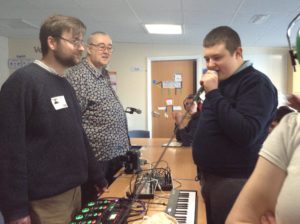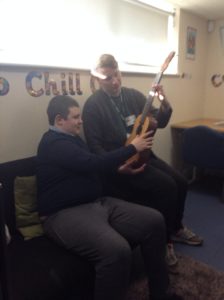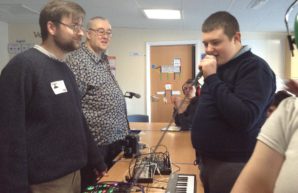Making an Inclusive Ensemble
Posted by Darren Leadsom on 16 August 2024
During the Spring 2024 term, More Music worked with pupils at Hillside Specialist Autism School and College in Longridge to develop an inclusive ensemble. The project was led by freelance musician Oliver Cross and Leroy Lupton from More Music. Oliver is a disabled neuro divergent composer/musician and an associate musician with Drake Music.
The project was developed in collaboration with Oliver and funded by Lancashire Music Hub. The aim was to give the Hillside students the opportunity to take part in making music and exercising creative agency using a range of accessible and traditional instruments. Oliver and Leroy worked with two classes at Hillside over six weeks (a KS3/KS4 group and a college group).
Here Oliver tells us about the project, the experience that the young people had and the learning he took from it, as well as sharing useful accessible virtual instruments which are available to any school.
—————————————————
Oliver Cross: We wanted to create an ensemble and allow them to perform together, and this was possible and achievable for one of the groups. I wanted the students to have agency in their music making, i.e., allow them to experience making their own musical decisions and enjoy it.
Simply bringing music into the school worked and produced a positive reaction. We got good levels of engagement which improved as the project developed. All the students we worked with enjoyed using the instruments, working together, and working with myself and Leroy. The iPad, Odd Ball. Korg Volcas and the loop station were all a success together with Leroy’s guitar and ukulele playing. All instruments used were accessible in that the students could get musical sounds out of them straight away. We set up loops using the Ipads and in Class 12 the students got up and danced. For me that was a clear indication that they were engaging with the music in a positive manner.

Oliver Cross and Simon Cross (left and middle)
The highlights of the project included a student in Class 12 who was largely non-verbal, who used the Trope app which creates sounds from the user touching or drawing on the Ipad screen. The music and visuals used in the app are calming, and this student wrote DREAM on the screen. I was very pleased with that.
In the other class a 14-year-old student surprised us with the speed with which he adapted to the technology and his incredible sense of musicality and rhythm. He improved on the beats we were using and taught himself to record them within minutes of having the app.
The overall highlight was the joy the students experienced taking part in music making.

Leroy Lupton (right)
ACCESSIBLE MUSIC APPS
All the apps I used on the Ipads are all appropriate for SEN settings due to the intuitive and accessible nature of their use. They were:
Figure – https://www.reasonstudios.com/mobile-apps
Figure is a powerful electronic music making tool and basic sequencer accessible to all. Each section, drums, bass, and lead requires simple touching of the screen to start making music, with the option to either play ‘freehand’ or to choose from a selection of rhythms. Keys are fixed and scale range and steps can be configured. Ipads allow the teacher/music leader to enable guided access ensuring the student doesn’t stray to other screens. It can be passed from student to student allowing a virtual ensemble to create and record drums, bass, and lead. We used this successfully in every lesson. Music making was almost instantaneous, but the application of thought and agency improves the quality of music. Because the iPad can be passed around it is easy to create and record a group tune. It’s inexpensive and the students enjoyed making some great tunes.
Trope – https://generativemusic.com/trope.html
Trope is a visual and musical experience app. Music is played by drawing lines and shapes on the touch screen. While there is no control over key and chords, the ambient and highly visual nature of the app makes for a good relaxation exercise at the end of a session. Class 12 used this as the basis of their performance piece ‘Dream’. In SEN settings it brings an element of calm into lessons, and we used it as the winding down section before ending or transitioning to a new activity. All the staff we worked with said they would like this app and thought it would be very useful in the SEN classroom.
Thumb Jam – https://thumbjam.com
Thumb Jam has over 40 real instruments sampled for use in the app. For music purposes it allows the student to play any of those instruments simply by touching the screen. The leader can fix the key which makes it compatible with other apps for an ensemble session. It is extremely easy to use particularly for the student who wants to play an individual instrument. The potentiometer in the Ipad makes it movement sensitive giving the opportunity to bend notes. This app worked well for individuals but gave the potential for a group performance.
OUTCOMES
Our emphasis was on giving them the opportunity to make music as soon as possible and this worked very well for them. If we measured success in smiles this was a very successful project. Musically both groups developed themes on a variety of instruments i.e., the Ipads, odd ball, keyboards and the Korg Volcas and we were able to record some excellent songs. In terms of musical agency every student who wanted to be was able to make music. I’m most pleased about this.
In an educational sense, the students developed skills of patience, concentration, confidence, and self-expression. Feedback from staff confirmed this, and it was apparent that the staff really enjoyed it too. We go to some schools where the teacher and TAs disappear when the session starts but that was not the case at Hillside.
The key learning for me on this project was that if you have a robust plan, you can differentiate your delivery to suit different abilities. We went in with the assumption that we would have an end performance. It soon became apparent that it would not be possible as the students needed to be in their familiar routine and environment for the sessions to work. However, we successfully delivered quite different sessions to the two groups, only possible because of the planning we had done.
The other learning was around the equipment. IPads really do well in this setting, as did the Oddball. I want schools to know that they do not need a lot of very expensive kit to introduce accessible music to their students. We can train the staff how to deliver this, they don’t need any deep musical knowledge.
SCHOOLS FEEDBACK
Laura Salisbury, Class Teacher at Hillside:
“Thank you to Oliver, Simon and Leroy for attend our school to provide music lessons for our students. Their knowledge of not only music but the needs of the students was exemplary and it provided our students with an experience that we have not been able to access before. Each student really enjoyed the workshop and it was lovely to see all of them smiling in each session.”
CLASS 1 TEACHER
When we split into two groups the pupils started to gain confidence. Within a few weeks and prior to the end of the sessions, F was using a microphone, K was fully engaged for the full session and was confident to use the equipment and sing into the microphone in front of a small group. C showed his true musical talent and was recognised for his rhythm and A was engaged with a smile and communicated/engaged with unfamiliar adults. Highlights were A taking part and being engaged, and C showing a true musical talent/skill
CLASS 2 TEACHER
The students were able to listen to and accept instructions from unfamiliar adults. They action the instructions at their level of understanding with minimal support.
The pupils enjoyed the session; they demonstrated relaxed physicality and confidence. they generalised and practised their turn-taking skills.
When challenged during the lesson, they demonstrated increasing resilience and continued with the lesson. E.g LC with and without the guitar!! Students not having the instrument/tech they felt they should have had. There was development of focus, attention/anticipation and communication skills.
Highlights were the progress seen of the whole group. By the final session the whole group accessed the session independently. They didn’t need adult support from the class team.
——————————————————————
Thanks to Laura Salisbury at Hillside School for helping to make the project happen and to Simon Cross for his support during sessions.
